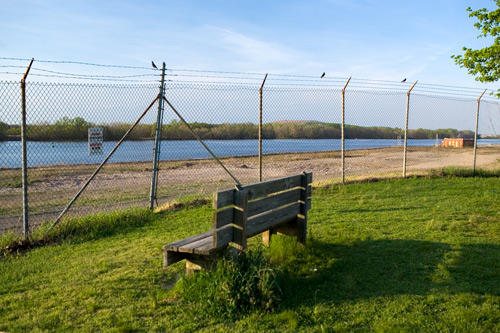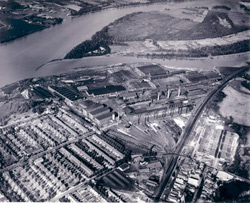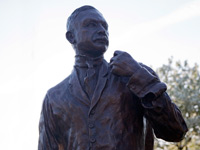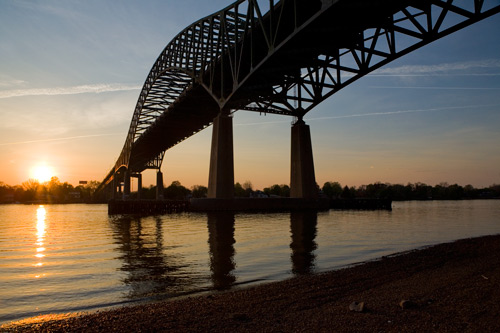|
|
|
28 April 09: ON THE DELAWARE . . .
Roeblin' on the River

All right, from here forward, "Summer of the Delaware" is simply "On the Delaware". No more seasonal constraints or weird constructs. Now this is fanfare, baby, let's
celebrate.
We'll kick off this rebirth of the series that never died by dropping our inner tube in with the tide and riding it 26 miles upstream to a little Jersey town called
Roebling, Roebling-on-the-Delaware if you're nasty.
Right along the river in Burlington County, just up from Burlington City and just down from Bordentown Town is a village, a planned village, for Roebling by Roebling.
In 1904, JP Morgan and Andrew Carnegie were expanding the US Steel empire by buying up smaller, extant steel concerns. In Trenton, there were over forty iron and steel
factories alone, and counted with the brick, wood, wool, textile and other industries, it's easy to see how Trenton was making and the world was taking. The largest of
the steel companies was New Jersey Iron and Steel, which caved in and cashed in to US Steel in a financial downturn. John Roebling's Sons Company refused to sell out
but was at a crossroads; the company, relocated to Trenton by the father in 1850, had grown beyond its resources and wanted to supply its own steel for the company's
flagship wire cable.
Charles Roebling, one of the sons, was a shareholder of the Pennsylvania Railroad, which conveniently owned tracks (formerly owned by the Camden & Amboy Railroad)
running alongside a 300 acre peach farm on the Delaware River just ten miles downstream from Trenton. He bought that farm and immediately began building furnaces,
mills, factories and so forth that would employ 1,400 people within five years. And those people would need places to live, raise families and be entertained, so he
built a town, too. The Roeblings never intended for the town to be named for them, but instead Kinkora, after the rail station that served Florence Township. Kinkora
didn't stick, though, as the PRR named the new town's station stop Roebling, and that the company was the very reason for the town, Roebling became the de facto name.
 This picture, by the Dallin Aerial Survey Company, was taken
in 1930 and gives an overview of the town's layout in relation to the river, railroad and company compound. Click it to go to the Dallin archive at the Hagley Library's
web site. This picture, by the Dallin Aerial Survey Company, was taken
in 1930 and gives an overview of the town's layout in relation to the river, railroad and company compound. Click it to go to the Dallin archive at the Hagley Library's
web site.
The Roeblings are quite a storied family. John Roebling studied architecture and engineering in Berlin, but when he moved to America in 1831, got into farming and with
his brother set up a town called Saxonburg north of Pittsburgh. After his brother died, he took up engineering again, and at a time when the trade was flourishing --
canals and railroads were booming. Roebling worked on the Allegheny Portage Railroad, a series of inclined planes that were the first railroad system across the
Appalachians (and which predated the Horseshoe Curve and the PRR Main Line by twenty years). The use of hemp rope on the Allegheny Portage inspired him to devise a
stronger rope, the wire cable that would make him rich and famous. Roebling's aqueduct for the Pennsylvania Canal across the Allegheny River in 1844 landed him a number
of subsequent contracts, including Pittsburgh's Smithfield Bridge, still the oldest standing steel bridge in the country (1846), and the four aqueducts for the Delaware
& Hudson Canal, including the one across the Delaware at Lackawaxen (from which I saw my first ever
wild bald eagle). In 1866 his bridge between Cincinnati Ohio and Covington Kentucky opened as the longest suspension bridge in the world, and a year later he began
designing his magnum opus, the Brooklyn Bridge. In 1869, while on the Brooklyn shoreline surveying for the bridge, a ferry crushed his foot; his refusal of medical
treatment led to an infection and ultimately the tetanus and lockjaw that killed him 24 days later.
John Roebling's son Washington Roebling, a decorated Civil War veteran who was instrumental in the battle of Gettysburg, took over the Brooklyn Bridge project and, like
his father, fell victim to it. He fought several bouts of decompression sickness (the bends) from working underwater on the caissons and was crippled and blinded in
1879. His wife Emily oversaw the completion of the bridge. Washington's brother Ferdinand Roebling was the financier of the John Roebling's Sons Company back in Trenton
and was an investor in several corporations including Otis Elevators, who used Roebling's wire cable. A third brother, Charles (whose son Washington Roebling II died on
the Titanic), was the Roebling who oversaw the company's growth into the new town just down the Delaware.
From Bruce Stutz' Natural Lives, Modern Times:
[A]long with the new furnaces, mills, and rail sidings, Charles built houses, a general store, a bakery, a drugstore, and a hotel. (To those who objected to
a bar in the hotel, Charles, the realist, replied that there was "no use in trying to make a mollycoddle out of a mill man.") . . . The Roeblings provided water, gas,
electricity, sewers, drainage, streets, watchmen, policemen, doctors, a jail, a theater (with a Brooklyn Bridge curtain across the stage), a public school, and, of
course, a park. "The man who owns a town," lamented Washington, "often wishes he had never been born." Kinkora became known as Roebling-on-the-Delaware.
Roebling-on-the-Delaware might as well be known as Roebling-almost-on-the-Delaware, though, because the town and its park are separated from the river by a long, barbed
wire fence (seen in the picture at the beginning of this post). The largest island in the entire Delaware River and Bay, Newbold Island, is just off the shore of the
factory, but you'd never know it standing outside its fence. The town and its park are on a bluff overlooking the river, but there's still a good hundred yards to the
bank of the river -- former marshland that was reclaimed by the Roebling company. Very little physical evidence still stands on this brownfield/no man's land, but there
are plenty of remnants. Under Roebling, the area was used for slag heaps and dumping, and under the Colorado Fuel and Iron Company, which bought out Roebling (then
under Charles Roebling Tyson, great-grandson of John) in 1952, new processes further contaminated the land before it shut the plant down for good in 1972. In 1984, the
Roebling Steel site made the EPA's National Priorities list as a toxic superfund site. On top of that, directly across the river is Waste Management's mountain of a
landfill at Tullytown.
View Larger Map
The cleanup has been going on ever since, and just last week, the EPA was awarded $25M of stimulus money for continued remedial work on the site. After the removal of
contaminants, they're hoping to restore the wetlands along the shore and open the land up as part of the Roebling Museum, housed in the company's main gate.
 John A Roebling's Sons Company has been gone for 57 years, but the town it created is alive and well. And as a testament to the company's legacy, so are so many
American icons it lent its wire cable to: Empire State Building (elevators), the Golden Gate, George Washington and Verrazano Bridges.
John A Roebling's Sons Company has been gone for 57 years, but the town it created is alive and well. And as a testament to the company's legacy, so are so many
American icons it lent its wire cable to: Empire State Building (elevators), the Golden Gate, George Washington and Verrazano Bridges.
In 2004, New Jersey Transit began operating the RiverLine light rail between Camden and Trenton on the former PRR right-of-way, with a stop at the old station in
Roebling. A year later, the town celebrated its centennial anniversary. And last year, it dedicated a sculpture of Charles Roebling by artist Morris Docktor in the town
circle on Main Street.
Roebling-on-the-Delaware is a little slice of the American Industrial Revolution's history, and it's 12 miles from the northeastern border of Philadelphia. I took a
little stroll through the town on Sunday. I've put 40 photos, about 7.7M total, all on one page for easy scrolling, so just give it a few seconds to load. To launch
this little Roebling photo essay, click
HERE.
Heading out of town, I took Hornberger Avenue past the Roebling School, built in 1914, and hung a right onto Delaware Avenue, which leads into Florence proper. (The US
Census recognizes Florence and Roebling as the Florence-Roebling census-designated
place, each an unincorporated area within Florence Township.) Delaware Avenue turns into Front Street and then into River Road. It was on River Road that I caught
the sunset beyond the Turnpike Bridge. And this Philly Skyline Turnpike Bridge Skyline is gonna take this post into the sunset.

NOTES & SOURCES:
• Roebling.org: official site of the village of Roebling.
• RoeblingMuseum.org: "Main Gate to Roebling History".
• InventionFactory.com: thorough history of the Roebling family and company.
• CivilWarStudies.org: Smithsonian account of Washington and Emily
Roebling.
• CentralJersey.com: Roebling cleanup gets boost
from feds, 4/16/09.
• Arcadia Publishing: Images of America: Roebling.
–B Love
|
|
|